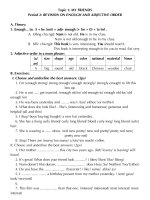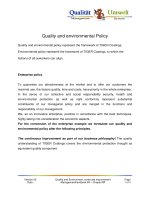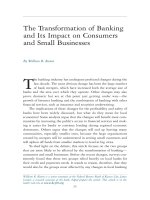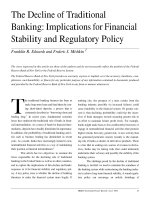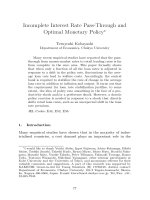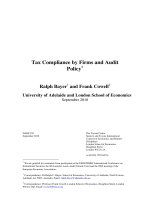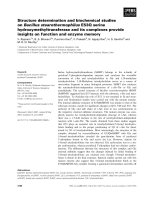Interest on Reserves and Monetary Policy doc
Bạn đang xem bản rút gọn của tài liệu. Xem và tải ngay bản đầy đủ của tài liệu tại đây (480.6 KB, 8 trang )
FRBNY Economic Policy Review / Forthcoming 1
I. Introduction
onetary policy operating procedures have long been
debated within the Federal Reserve and among
monetary economists at large. For instance, economists have
disagreed about whether a central bank should utilize bank
reserves or the interest rate as the policy instrument. For the
time being at least, the Fed has settled on an interest rate policy
instrument and has announced its current federal funds rate
target since 1994. The focus on interest rate policy is reflected
in the ubiquitous use of the Taylor rule in monetary policy
analysis.
Oddly enough, just as the longstanding debate over bank
reserves and the federal funds rate was set aside, four
developments combined to renew an interest in operating
procedures. First, economists began to worry that
technological progress in the payments system could threaten a
central bank’s leverage over interest rates in the future.
1
Second, deflation in Japan led to a zero interest rate policy that
stimulated a reconsideration of the nature of monetary policy
transmission. Third, Congress considered legislation that
would empower the Fed to pay explicit interest on bank
reserves.
2
Fourth, during the 1980s and 1990s, many of the
world’s central banks moved from credit controls to market-
based procedures for implementing monetary policy. Today,
the world’s major central banks implement monetary policy by
manipulating short-term interest rates. Yet important
differences remain in the procedures by which short-term rates
are managed. There is considerable interest in comparing
alternatives currently in use and in exploring new procedures
that might afford benefits in the future.
3
Motivated by these four developments, this paper highlights
the role of interest on reserves in understanding the leverage
that central banks exert over interest rates and explores the
potential for interest on reserves to improve the
implementation of monetary policy. I find that interest on
reserves can and should be employed as a policy instrument
equal in importance with open market operations. In effect, my
paper resolves the historical dispute over bank reserves and
interest rate operating procedures by pointing out how a
central bank can target both independently. I conclude that a
central bank without the authority to pay and vary interest on
reserves at a market rate is at a considerable disadvantage in the
implementation of monetary policy.
Economists, most notably Friedman (1959), have long
advocated the payment of interest on reserves at a market rate
in order to eliminate the distortions associated with the tax on
reserves.
4
To a large extent, the legislation mentioned above
was introduced to address the reserve tax. I am proposing
something more: that interest on reserves be adopted as an
Marvin Goodfriend
This paper is based on remarks by the author at the conference’s roundtable
discussion “Monetary Policy in the New Millennium: The Evolution of
Central Banks’ Operating Procedures and Practices.” The paper also benefited
from a presentation at the European Central Bank. Discussions with Ignazio
Angeloni, Vitor Gaspar, Bob Hetzel, Bob King, Sandy Krieger, Ken Kuttner,
Jeff Lacker, Ben McCallum, John Weinberg, and Steve Williamson are much
appreciated. The views expressed are those of the author and do not
necessarily reflect the position of the Federal Reserve Bank of New York, the
Federal Reserve Bank of Richmond, or the Federal Reserve System.
Interest on Reserves
and Monetary Policy
Marvin Goodfriend is senior vice president and policy advisor at the
Federal Reserve Bank of Richmond.
M
2 Interest on Reserves and Monetary Policy
instrument of monetary policy in practice.
5
Some economists
have argued that paying interest on reserves might actually
impair the ability of a central bank to conduct monetary
policy.
6
More recently, however, interest rate rules for
monetary policy have been shown to deliver coherent
outcomes for the price level and real variables, even in models
that ignore the demand for reserves and money completely.
7
These latest findings imply that interest rate rules could achieve
broader macroeconomic objectives in much the same way,
whether or not interest is paid on reserves.
I build up the analytical core of the paper in Section II by
reviewing the nature of the zero bound on nominal interest
rates. I explain that a central bank can manipulate short-term
interest rates either by employing open market operations to
manage the interest opportunity cost of holding reserves or by
varying the interest paid on reserves. I then explain how a
central bank could employ interest on reserves together with
open market operations to target independently and
productively both short-term interest rates and the aggregate
quantity of bank reserves.
Section III employs the reasoning developed above to
address the viability of interest rate policy in the event that
technological progress in the payments system causes the
transaction demand for bank reserves and currency to shrink
significantly and even to disappear completely. Such
developments will indeed threaten the Fed’s leverage over
interest rates if the central bank persists in using its current
operating procedures. However, a central bank’s leverage over
interest rates can be preserved fully by employing interest on
reserves as a monetary policy instrument.
The financing of interest on reserves is considered in
Section IV. Paying a market rate of interest on reserves could
very well increase net interest transfers from the central bank to
the Treasury. At worst, it would have a relatively small adverse
effect on government finances. Interest on reserves could create
cash flow problems for monetary policy on occasion, but these
would be manageable.
II. The Interest-on-Reserves Regime
The means by which the Federal Reserve sets the level of the
federal funds rate at a point in time is well known. In current
practice, the Federal Open Market Committee (FOMC)
announces a target for the federal funds rate and instructs the
trading desk at the New York Fed to use open market
operations to provide the quantity of reserves and currency
that the economy demands at that federal funds rate. The
quantity of monetary base demanded adjusts so that the
implicit marginal liquidity services yield exactly matches the
interest opportunity cost spread, that is, the federal funds rate
target minus the (zero) interest rate on reserves.
I came to view the process by which a central bank manages
the interbank rate in a different light a few years ago in a paper
on the zero bound on interest rate policy.
8
Obviously, at the
zero bound it is no longer possible for a central bank to operate
on the interest opportunity cost spread. The spread is zero.
Nevertheless, a central bank still may be said to manage the
interbank rate when it is zero. Thus, something other than
open market operations and the interest opportunity cost
spread must matter for the implementation of interest rate
policy.
Irving Fisher developed the fundamental logic of the lower
bound on interest rates in his famous book The Theory of
Interest. He pointed out that if a commodity could be stored
costlessly over time, then the rate of interest in units of that
commodity could never fall below zero.
9
Surprisingly, as far as
I know, Fisher did not apply that reasoning to monetary issues.
In my paper, I applied Fisher’s logic to point out that banks will
never lend reserves to each other at negative (nominal) interest
if reserve deposits are costless to store (carry) at the central
bank. The zero bound on the nominal interbank rate is a
consequence of the fact that a central bank stores bank reserves
for free.
Thinking about the zero bound this way suggests that
variable interest on reserves could be utilized routinely and
productively as an instrument of monetary policy. The Fed
could replace its current operating procedures with a new
interest-on-reserves regime. For heuristic purposes, I describe
the implementation of the new regime in two steps, although
the steps would take place simultaneously in practice. First, the
Fed would purchase additional securities in the open market,
adding enough reserves to satiate the market and drive the
federal funds rate to zero. The Bank of Japan actually
implemented this step recently with its zero interest rate policy.
Second, the Fed would begin to pay interest on bank reserves
held on deposit at the Federal Reserve Banks. If the current
intended target for the overnight rate were, say, 5 percent, then
the Fed would pay interest on reserves at 5 percent.
It is easy to see why the rate of interest paid on reserves
would determine the overnight market rate in this regime.
Clearly, by Fisher’s logic the 5 percent interest rate paid on
reserves would put a 5 percent floor under which banks would
not lend reserves to each other. The 5 percent floor would also
be a ceiling above which banks would not lend to each other
either. The reason is that there could be no interest opportunity
cost spread in equilibrium if the reserve market is satiated so
that the marginal liquidity services yield on reserves is zero.
Currency would not need to pay interest in this regime. The
FRBNY Economic Policy Review / Forthcoming 3
The Market for Bank Reserves
Interest on
reserves
Reserve supply
Reserves
Interest rate
Reserve
demand
central bank would continue to accommodate the demand for
currency as the Fed does today.
Thus, the interest-on-reserves regime would enable the Fed
to exercise control of the overnight interest rate exactly as it
does now. The main business of the FOMC would be to choose
the interest rate paid on reserves, which would govern the level
of short-term rates more generally as the federal funds rate
target does today under the Fed’s current operating
procedures.
However, the interest-on-reserves regime would differ from
the Fed’s current operating procedures in one important
respect. Open market operations would cease to support the
interbank rate in the new regime. Open market operations
would support neither the interest opportunity cost spread
(which would be zero) nor the level of the interbank rate
(which would be determined by the rate of interest paid on
reserve balances at the central bank). Therefore, open market
operations would be free to pursue another monetary policy
objective.
Specifically, a central bank would be free to target any
aggregate quantity of reserves above the minimum required to
keep the interbank rate at the interest-on-reserves floor. This
point is illustrated in the exhibit. The kink in the reserve
demand locus reflects the fact that the quantity of reserves
demanded rises as the market interest rate falls and becomes
infinitely elastic when the market interest rate hits the rate paid
on reserves. Reserve supply is vertical at the aggregate quantity
of reserves supplied by the central bank. As long as the supply
of reserves is large enough to cut the horizontal portion of the
reserve demand locus, the central bank could use open market
operations to target bank reserves, and independently use
interest on reserves to pursue interest rate policy.
This opens an important new possibility for monetary
policy: separate interest rate and bank reserves channels of
monetary policy transmission. My zero-bound paper
(Goodfriend 2000) explains how (negative) interest on reserves
and reserve targeting could play independent and
complementary roles in overcoming the zero bound on interest
rates. In the paper, I pointed to the potential for quantitative
policy to operate productively on broad liquidity even if narrow
liquidity were satiated with the interbank rate at the interest-
on-reserves floor. It is noteworthy that currently the Bank of
Japan is considering supplementing its zero interest rate policy
with quantitative easing. Most monetary economists agree that
aggressive open market purchases in Japan could stimulate
aggregate demand even with short rates immobilized at zero.
Such logic suggests that the independent use of quantitative
policy made possible in an interest-on-reserves regime could be
of considerable value even when the interest rate is not
immobilized at the zero bound.
It is beyond the scope of this paper to present a model of the
separate interest rate and bank reserves channels of monetary
transmission in an interest-on-reserves regime. However, one
can understand the potential usefulness of the additional
degree of monetary policy freedom as follows. Narrow liquidity
services provided by the monetary base enable banks and the
public to economize on time and effort in settling transactions.
Broad liquidity, however, is a service yield provided by assets
more generally according to how easily they can be turned into
cash, either by sale or by serving as collateral for external
finance. Households and firms are routinely subjected to
liquidity shocks in which the flow of current income is
insufficient to finance desired expenditures. Broad liquidity
services are valued because they minimize the exposure of
households and firms to the external finance premium.
10
In the interest-on-reserves regime, bank reserves would pay
a market rate of interest but would yield no narrow liquidity
services at the margin. Hence, in such a regime, bank reserves
would be equivalent to safe government debt with a floating
daily rate of interest. However, bank reserves would continue
to provide broad liquidity services at the margin in an interest-
on-reserves regime, much as short-term government debt
does. Holding interest on reserves fixed, an increase in bank
reserves would increase the aggregate supply of broad liquidity.
Thus, open market operations would have the potential to
manage productively the aggregate quantity of broad liquidity
in the economy independently of interest rate policy. A central
bank could increase broad liquidity in the economy by using
newly created reserves to acquire less liquid assets or by
financing a temporary government budget deficit.
Why might a central bank value the latitude to pursue
separate interest rate and bank reserves policies? Interest rate
4 Interest on Reserves and Monetary Policy
policy could continue to be utilized to maintain overall
macroeconomic stability. Bank reserves policy could then
address financial market objectives. In the long run, a central
bank could pursue an objective for bank reserves to optimize
the broad liquidity services provided by the floating stock of
government debt.
11
In the short run, for example, a central
bank could increase bank reserves in response to a negative
shock to broad liquidity in banking or securities markets or an
increase in the external finance premium that elevated spreads
in credit markets. The increase in bank reserves would help to
stabilize financial markets by offsetting the temporary
reduction in the private supply of broad liquidity. The latitude
to pursue bank reserves policy and interest rate policy
separately would be useful to the extent that shocks in financial
markets and the macroeconomy are somewhat independent of
each other.
Recent experience illustrates this point. Consider the fact
that the Fed cut interest rates sharply in response to two of the
most serious financial crises in recent years: the October 1987
stock market break and the turmoil following the Russian
default in 1998. Arguably, in retrospect, interest rate policy
remained too easy for too long in both cases. The latitude to
increase bank reserves independently of interest rate policy
conceivably could have enabled the Fed to stabilize financial
markets in those cases with less risk of stimulating the overall
economy excessively.
To some degree, the Fed can already manage broad liquidity
under current operating procedures by changing the
composition of its assets, for example, by selling liquid short-
term Treasury securities and acquiring less liquid longer term
securities. However, the government debt injected into the
economy in this way would not be as liquid as newly created
base money. More importantly, the Fed’s ability to affect broad
liquidity in this way is strictly limited by the size of its balance
sheet. For the broad liquidity management contemplated here
to be effective, a central bank might need the latitude to enlarge
its balance sheet considerably and to vary the size of its balance
sheet within a wide range independently of interest rate policy.
That is not possible under the Fed’s current operating
procedures.
Monetary economists have long accepted the view that a
central bank must choose between an interest rate instrument
and a bank reserves policy instrument. Bank reserves and the
interest rate, it is said, cannot be targeted independently.
12
The
conventional view is misleading because it ignores the fact that
interest on reserves at a central bank can be employed
productively as a policy instrument. The fact that some central
banks, including the Fed, have not yet been authorized to pay
and vary interest on reserves should not cloud our
understanding of the potential role of interest on reserves in
implementing monetary policy. Nor should it preclude one’s
investigation of the benefits that full exploitation of the
interest-on-reserves regime could achieve.
III. The Robustness of a Central
Bank’s Leverage over Interest
Rates
In this section, I use the above framework to assess the
robustness of a central bank’s leverage over interest rates in a
world where the transaction demand for bank reserves and
even currency shrinks significantly and perhaps disappears
completely. Is a central bank’s leverage over interest rates
threatened by banks’ ongoing economization on reserves? The
short answer is it need not be. My answer has four parts.
First, it is worth remembering that the reduction in reserve
demand is in large part the result of the failure of reserves to pay
interest. The incentive to economize on reserves was greater
when inflation made nominal interest rates much higher than
they are today. But even at current interest rates, banks
continue to find ways to avoid holding reserves.
13
A falling
demand for reserves is far from inevitable if the opportunity
cost of holding reserve balances at a central bank is reduced by
achieving price stability or by paying interest on reserves.
Second, we saw above that in general, a central bank need
not maintain an opportunity cost of reserves in order to
implement interest rate policy. A central bank could push the
market rate down to the interest-on-reserves floor and vary
interest on reserves to implement interest rate policy as
described in Section II. With no opportunity cost of holding
reserve deposits, there would be no incentive for banks to pay
anything to economize on reserve balances. The
demonetization of the reserve market would likely slow or stop,
and reverse if reserve avoidance has an ongoing cost.
Third, an extremely small, unstable aggregate demand for
reserves could create a problem for the Fed’s current
procedures. Today, the Fed defends its announced funds rate
target with relatively infrequent interventions in the reserves
market. Movements in the funds rate could become erratic if
reserve demand shrinks further. The Fed might feel compelled
to intervene more often. More frequent interventions,
however, would tend to weaken market forces that would
otherwise stabilize the funds rate around the Fed’s intended
target. The Fed could be drawn into a more or less continuous
defense of a narrow band around its intended federal funds
rate. In so doing, the Fed would end up inserting itself between
trades to redistribute reserves among banks. That outcome
would be highly inefficient because banks utilize the federal
FRBNY Economic Policy Review / Forthcoming 5
funds market actively in the current environment, where
reserves are costly to hold.
Contrast that possibility with what would happen in the
interest-on-reserves regime. The central bank would control
the overnight interest rate tightly with its interest-on-reserves
policy instrument without any opportunity cost of reserves.
Banks would continue to transfer reserve deposits among
themselves to settle payment orders initiated by their
depositors. However, banks would greatly enlarge their
inventory of reserves, stockouts would be infrequent, and
banks would redistribute reserves among themselves much less
often via the interbank credit market. The overnight interbank
market might become less active or disappear altogether, but
only because banks had a more economical way to manage
their reserves in an interest-on-reserves regime.
For our last look into the future, we consider what would
happen if technological progress in the payments system
caused the monetary base to lose its medium-of-exchange role
gradually, and to completely lose that role eventually. This
could happen if the banking system developed an electronic
settlement system independent of the central bank, and
currency was abandoned in favor of electronic devices that
could access bank deposits remotely.
14
Clearly, interest rate policy implemented by the Fed’s
current operating procedures could not survive in this case. If
the Fed persisted in implementing interest rate policy with its
current procedures, the Fed would continually sell securities to
withdraw reserves and currency. Reserves, for example, would
be withdrawn to keep their marginal narrow liquidity services
yield from falling below the interest opportunity cost
represented by the federal funds rate target. If the transaction
demand for reserves disappeared completely, the Fed would
end up withdrawing all bank reserves in defense of its federal
funds rate target and lose its power to influence market interest
rates. It is difficult to say what would happen next. Suffice it to
say that economists and central bankers have reason to be
concerned about this possibility.
However, the Fed’s leverage over interest rates would be
completely secure if it switched to the interest-on-reserves
regime described above. Instead of withdrawing the monetary
base, the central bank could let banks accumulate the unneeded
currency and reserves. Banks could exchange currency for
reserve balances earning the policy rate, which would also equal
the market rate of interest. The aggregate quantity of reserves
held by banks would be determined by the central bank’s
reserve target. Banks would regard deposits at the central bank
as government debt with a floating daily market rate of interest
and value them as such. Such developments would not
interfere at all with the central bank’s power to implement
interest rate policy in an interest-on-reserves regime.
15
I conclude that the threat to interest rate policy from the
shrinkage or disappearance of the transaction demand for the
monetary base is a consequence of the operating procedures
that a central bank chooses to use. A central bank’s leverage
over interest rates is fundamentally secure as long as it utilizes
the interest-on-reserves regime, which does not require open
market operations to maintain a scarcity of reserves relative to
their demand so as to support a positive interest opportunity
cost of reserves.
IV. Financing Interest on Reserves
Paying interest on reserves would seem to be expensive from
the Treasury’s point of view. Interest earnings ordinarily
transferred by a central bank as tax revenue to the Treasury
would be diverted to pay interest on reserves. Moreover, the
payment of interest on reserves would induce banks to enlarge
substantially the quantity of reserves demanded, greatly
enlarging the interest that a central bank would have to pay.
This section addresses the financing of interest on reserves, and
argues that the fiscal implications are likely to be more
favorable than might be supposed.
Implementing an interest-on-reserves regime has two
effects on government finances. First, there is an effect due to
the increase in reserve deposits and assets acquired by a central
bank as a result of the regime change. Second, there is an effect
due to the payment of interest on preexisting reserve deposits.
I consider these in turn.
Suppose a central bank such as the Fed confines its asset
purchases mainly to Treasury securities. In that case, interest
on the increase in reserves will be self-financing if there is a
positive spread between longer term Treasury securities and
the rate of interest on reserves. Reserve balances at the central
bank paying market interest are like one-day Treasury
securities. Hence, interest rate spreads between longer term
Treasury securities and overnight deposits at the central bank
should exhibit term premia ordinarily reflected in the Treasury
yield curve. Therefore, a central bank such as the Fed should be
able to self-finance interest on the enlarged demand for
reserves in the new regime. In fact, the net interest spread
earned on new assets acquired in the interest-on-reserves
regime would raise additional revenue for the central bank.
16
What about the effect on the government’s finances of
paying interest on preexisting reserve holdings? Paying a
market rate of interest on reserves held previously would
reduce transfers from the central bank to the Treasury because
it would eliminate the tax on preexisting reserves. That said,
reserve balances currently held by banks are relatively small,
6 Interest on Reserves and Monetary Policy
and banks are likely to economize further on reserves if they
continue to earn no interest. Moreover, net interest earned by
expanding the central bank’s balance sheet could offset, or
more than offset, these losses. At most, switching to the
interest-on-reserves regime would have a relatively small
adverse effect on government finances and could very well
increase central bank transfers to the Treasury.
Paying a market rate of interest on reserves could create cash
flow problems for a central bank. One problem is that interest
on reserves would be paid on a daily basis, but interest earnings
would not accrue on a daily basis. Interest on short-term
securities is paid on a discount basis rather than on a daily basis
and interest on longer term securities is paid at infrequent
intervals. Also, inevitably there will be periods in which the
yield curve slopes downward, perhaps because the central bank
had recently tightened policy and markets expect a return to
lower overnight interest rates in the future. In such periods,
interest on the central bank’s portfolio could conceivably fail to
cover interest on reserves.
Cash flow problems could be addressed in a number of
ways. A central bank with sizable earnings on assets acquired
with non-interest-bearing currency could utilize those net
interest earnings to help pay interest on reserves. If necessary, a
central bank could draw down its capital to help pay interest on
reserves, replenishing its capital when cash flows are positive. If
a central bank held Treasury securities, modifications could be
made in the timing of interest payments from the Treasury
once its securities were acquired by the central bank. These
important operational issues must be addressed before the
interest-on-reserves regime could be implemented. On the
whole, however, cash flow problems would be manageable.
V. C o n c l u s i o n
Open market operations are neither necessary nor sufficient to
implement interest rate policy. These operations are not
necessary because they work by restricting the supply of
reserves in order to maintain a positive marginal liquidity
services yield and an interest opportunity cost of reserves. By
paying and varying interest on reserves, a central bank could
exert leverage over market rates without maintaining an
interest opportunity cost spread. Open market operations are
not sufficient to implement interest rate policy either, because
they govern only the interest opportunity cost spread. The level
of the interbank rate is determined only if, in addition, the rate
of interest paid on reserves is specified at zero or otherwise.
This unorthodox way of viewing monetary policy operating
procedures is entirely consistent with conventional monetary
theory. The change of perspective, however, enables us to
better appreciate the potential role of interest on reserves for
monetary policy. The main practical point of this paper is that
a central bank can implement interest rate policy by paying and
varying interest on reserves without maintaining an interest
opportunity cost spread as long as the preexisting supply of
bank reserves is large enough to keep the interbank rate pressed
down to the interest-on-reserves floor.
The interest-on-reserves regime has four attractive features.
First, the regime would make full use of two monetary policy
instruments—open market operations and interest on
reserves—to enable a central bank to simultaneously pursue
interest rate policy and an independent objective for aggregate
bank reserves. That would potentially improve on the Fed’s
current operating procedures that obligate bank reserves to
support interest rate policy. Bank reserves could be varied to
offset shocks to the private supply of broad liquidity in
financial markets in the interest-on-reserves regime, while
interest rate policy could be used to stabilize the overall
macroeconomy.
Second, the interest-on-reserves regime would perfectly
preserve a central bank’s leverage over interest rates, even in the
unlikely event that the transaction demand for base money
disappeared entirely in the future. Moreover, banks would have
no incentive to avoid central bank reserves in such a regime. In
contrast, the Fed’s current operating procedures might not fare
well if the demand for reserves were to shrink further and
would not work at all if the transaction demand for reserves
were to disappear altogether.
Third, the interest-on-reserves regime might very well be
self-financing; it even has the potential to generate significant
additional revenue for the government. At worst, switching to
the interest-on-reserves regime would involve a relatively small
adverse effect on government finances. Paying a market rate of
interest on reserves could create cash flow problems for a
central bank; but these problems would be manageable.
Finally, the interest-on-reserves regime would eliminate
entirely distortions in financial markets due to the tax on
reserves. Banks would save resources that had been devoted to
economizing on reserves. An abundance of costless, safe
reserves would substitute somewhat for the costly and risky
extension of private credit in the process of making payments.
The shrinkage of private credit in making payments, in turn,
would help a central bank to limit the extension of its own
credit in support of the payments system.
Endnotes
FRBNY Economic Policy Review / Forthcoming 7
1. See Friedman (1999) and the various papers in Posen (2000).
2. See Meyer (2001).
3. For instance, Woodford (2000) analyzes the channel system of
interest rate control and compares it with the Fed’s current operating
procedures. See Borio (1997) for a survey.
4. See also Fama (1983) and Hall (1983).
5. A few economists have discussed the use of interest on reserves as a
policy instrument. Hall (1983, 1999) shows how interest on reserves
could be utilized to control the price level. Goodhart (2000) and
Woodford (1999) discuss how interest on reserves could be utilized to
implement monetary policy in a world without money. Interest on
deposits at the central bank is also an important component of the
channel system for implementing monetary policy.
6. See Sargent and Wallace (1985) and Smith (1991).
7. See, for example, Kerr and King (1996), McCallum (2001), and
Woodford (1999).
8. See Goodfriend (2000).
9. A concise statement such as this does not actually appear in the
book. The point is made through a series of examples. See Fisher
(1930, pp. 186-94).
10. See Bernanke and Gertler (1995).
11. Economists have recently begun to analyze the role and
management of broad liquidity in the economy. For instance, Aiyagari
and McGrattan (1998), Heaton and Lucas (1996), and Holmstrom
and Tirole (1998) analyze broad liquidity and consider how much the
government should supplement the private supply of broad liquidity
with a floating stock of government debt.
12. Economists such as Poole (1970) recognized that a central bank
could pursue a combination policy involving both bank reserves and
the interest rate. A combination policy can be interpreted as a rule that
uses a weighted average of reserves and the interest rate as the policy
instrument. In the conventional analysis, however, no interest is paid
on reserves and the two instruments cannot be chosen independently
of each other.
13. For instance, the recent introduction of sweep accounts greatly
reduced required reserves in the United States.
14. Friedman (1999) and King (1999) regard such an outcome as a real
possibility.
15. Goodhart (2000, part 3) and Woodford (1999, pp. 72-5; 2000,
p. 255) reach a similar conclusion.
16. Note that the liquidity spread would tend to shrink as the supply
of reserves increased.
References
8 Interest on Reserves and Monetary Policy
Aiyagari, Rao, and Ellen R. McGrattan. 1998. “The Optimum Quantity
of Debt.” Journal of Monetary Economics 42, no. 3
(December): 447-70.
Bernanke, Ben, and Mark Gertler. 1995. “Inside the Black Box: The
Credit Channel of Monetary Transmission.” Journal of
Economic Perspectives 9, no. 4 (fall): 27-48.
Borio, Caudio E. V. 1997. “The Implementation of Monetary Policy
in Industrial Countries: A Survey.” Bank for International
Settlements, July.
Fama, Eugene F. 1983. “Financial Intermediation and Price Level
Control.” Journal of Monetary Economics 12, no. 1 (July): 7-28.
Fisher, Irving. 1930. The Theory of Interest. Fairfield, N.J.:
Augustus M. Kelley (1986 reprint of 1930 edition).
Friedman, Benjamin. 1999. “The Future of Monetary Policy.” NBER
Working Paper no. 7420.
Friedman, Milton. 1959. A Program for Monetary Stability.
New York: Fordham University Press.
Goodfriend, Marvin. 2000. “Overcoming the Zero Bound on Interest
Rate Policy.” Journal of Money, Credit, and Banking 4,
no. 32, part 2 (November): 1007-35.
Goodhart, Charles A. E. 2000. “Can Central Banking Survive the IT
Revolution?” International Finance 3, no. 2 (July): 189-209.
Hall, Robert E. 1983. “Optimal Fiduciary Monetary Systems.”
Journal of Monetary Economics 12, no. 1 (July): 33-50.
———. 1999. “Controlling the Price Level.” NBER Working Paper
no. 6914.
Heaton, John, and Deborah Lucas. 1996. “Evaluating the Effects of
Incomplete Markets on Risk Sharing and Asset Pricing.” Journal
of Political Economy 104 (June): 443-87.
Holmstrom, Bengt, and Jean Tirole. 1998. “Private and Public Supply of
Liquidity.” Journal of Political Economy 106 (February): 1-40.
Kerr, William, and Robert G. King. 1996. “Limits on Interest Rate Rules
in the IS Model.” Federal Reserve Bank of Richmond Economic
Quarterly 82, no. 2 (spring): 47-75.
King, Mervyn. 1999. “Challenges for Monetary Policy: New and Old.”
Bank of England Quarterly Bulletin 39, no. 4 (November):
397-415.
McCallum, Bennett T. 2001. “Monetary Policy Analysis in Models
without Money.” NBER Working Paper no. 8174.
Meyer, Laurence H. 2001. “Payment of Interest on Reserves.”
Testimony before the Financial Services Subcommittee on
Financial Institutions and Consumer Credit, U.S. House of
Representatives, March 13.
Poole, William. 1970. “Optimal Choice of Monetary Policy Instru-
ments in a Simple Stochastic Macro Model.” Quarterly Journal
of Economics 84, no. 2 (May): 197-216.
Posen, Adam S., ed. 2000. International Finance 3, no. 2 (July).
Sargent, Thomas, and Neil Wallace. 1985. “Interest on Reserves.”
Journal of Monetary Economics 15, no. 3 (May): 279-90.
Smith, Bruce D. 1991. “Interest on Reserves and Sunspot Equilibria:
Friedman’s Proposal Reconsidered.” Review of Economic
Studies 58, no. 1 (January): 93-105.
Woodford, Michael. 1999. “Interest and Prices.” Unpublished paper,
Princeton University.
———. 2000. “Monetary Policy in a World without Money.”
International Finance 3, no. 2 (July): 229-60.
The views expressed are those of the author and do not necessarily reflect the position of the Federal Reserve Bank of New York,
the Federal Reserve Bank of Richmond, or the Federal Reserve System. The Federal Reserve Bank of New York provides no
warranty, express or implied, as to the accuracy, timeliness, completeness, merchantability, or fitness for any particular
purpose of any information contained in documents produced and provided by the Federal Reserve Bank of New York in any
form or manner whatsoever.
